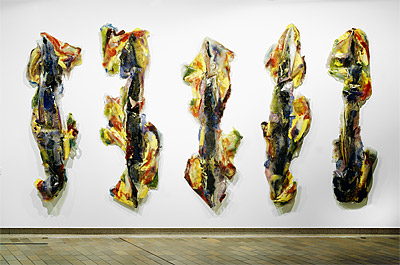Richard
VAN BUREN
United States of America
1937
For Najeeb
1972
polyester resin, fibreglass, pigments and glitter
not signed, not dated
installation (variable)
350.0 (h)
x 600.0 (w)
x 15.0 (d)
cm
Purchased 1974
National Gallery of Australia, Canberra
NGA 1974.388.A-E
© Richard Van Buren
Like many of his contemporaries, Van Buren placed an emphasis on ‘process’ and the inherent properties of the materials employed. Initially he used the varying densities of fibreglass resin to highlight its transparency and opacity. In the early 1970s the artist introduced colour by mixing a variety of other materials with fibreglass resin. This is evident in For Najeeb 1972, a work dedicated to the artist’s father.
Van Buren began his work by laying a sheet of plastic over a littering of bottles, cans, wooden planks and other discarded objects found in his studio. Across this uneven surface he poured liquid polyester resin, its viscosity altered by the addition of fibreglass and hardening agents, as well as other materials including charcoal, plaster, glass shavings, glitter, metallic powders and pigments. In addition to the natural translucency of the fibreglass, the pigments and other additions become effectively embedded in the media. The colours—often in jarring combinations—become the substance of the sculpture. The resulting work is a combination of materials, artistic decisions and chance.[1]
For Najeeb exhibits a captured fluidity[2] and its vibrant colour hints at the psychedelic designs of the fashion world of the 1970s. The critic Carter Ratcliff claimed that Van Buren’s work was indebted to the precedent of Jackson Pollock and had ‘brought gestural abstraction into sculpture’.[3] Van Buren cautioned against such comparisons, however:
I think of them as sculpture, but I don’t care. The only thing that bothers me is when someone says it’s painting and they relate it to painting. That’s fine if that’s where their heads are at, but it’s just bringing too much to it. I think they’re bad paintings, really bad paintings.[4]
For Najeeb reveals the equivocal nature of art at this time: paintings are on the floor and sculptures on the wall.
Steven Tonkin 2003[5]
then Assistant Curator, Research
National Gallery of Australia, Canberra
[1] Carter Ratcliff, ‘Solid Color’, ARTnews vol 71 no 3, May 1972, p 28
[2] Another example in Soft sculpture is Lynda Benglis’s Untitled (Polly’s pie II)1968
[3] Ratcliff 1972, p 62B
[4] Richard van Buren, quoted in Phyllis Tuchman, ‘An interview with Richard van Buren’, Artforum vol 8 no 4, December 1969, p 56
[5] Adapted from Steve Tonkin’s unpublished manuscript, ‘Richard Van Buren: For Najeeb’, in ‘American painting and sculpture in the National Gallery of Australia’, 2004

